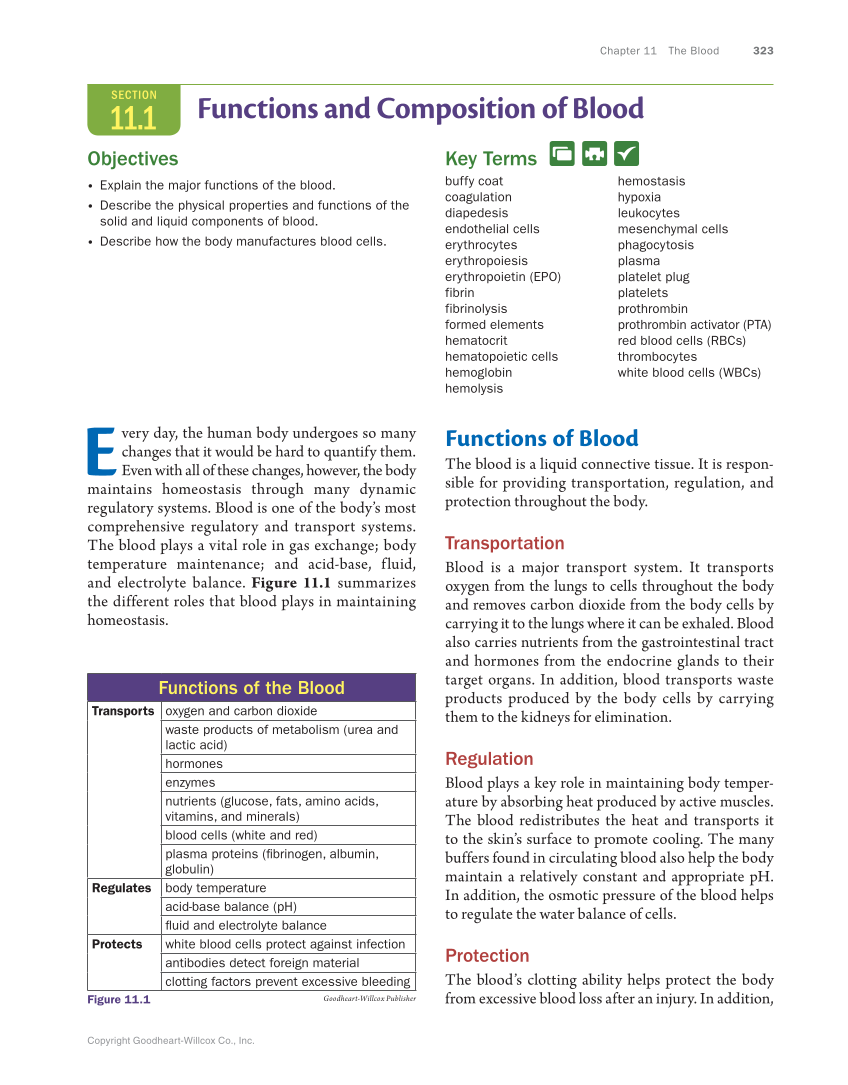Chapter 11 The Blood 323 Copyright Goodheart-Willcox Co., Inc. E very day, the human body undergoes so many changes that it would be hard to quantify them. Even with all of these changes, however, the body maintains homeostasis through many dynamic regulatory systems. Blood is one of the body’s most comprehensive regulatory and transport systems. The blood plays a vital role in gas exchange body temperature maintenance and acid-base, fluid, and electrolyte balance. Figure 11.1 summarizes the different roles that blood plays in maintaining homeostasis. Functions of Blood The blood is a liquid connective tissue. It is respon- sible for providing transportation, regulation, and protection throughout the body. Transportation Blood is a major transport system. It transports oxygen from the lungs to cells throughout the body and removes carbon dioxide from the body cells by carrying it to the lungs where it can be exhaled. Blood also carries nutrients from the gastrointestinal tract and hormones from the endocrine glands to their target organs. In addition, blood transports waste products produced by the body cells by carrying them to the kidneys for elimination. Regulation Blood plays a key role in maintaining body temper- ature by absorbing heat produced by active muscles. The blood redistributes the heat and transports it to the skin’s surface to promote cooling. The many buffers found in circulating blood also help the body maintain a relatively constant and appropriate pH. In addition, the osmotic pressure of the blood helps to regulate the water balance of cells. Protection The blood’s clotting ability helps protect the body from excessive blood loss after an injury. In addition, SECTION 11.1 Functions and Composition of Blood Objectives · Explain the major functions of the blood. · Describe the physical properties and functions of the solid and liquid components of blood. · Describe how the body manufactures blood cells. Key Terms buffy coat coagulation diapedesis endothelial cells erythrocytes erythropoiesis erythropoietin (EPO) fibrin fibrinolysis formed elements hematocrit hematopoietic cells hemoglobin hemolysis hemostasis hypoxia leukocytes mesenchymal cells phagocytosis plasma platelet plug platelets prothrombin prothrombin activator (PTA) red blood cells (RBCs) thrombocytes white blood cells (WBCs) Functions of the Blood Transports oxygen and carbon dioxide waste products of metabolism (urea and lactic acid) hormones enzymes nutrients (glucose, fats, amino acids, vitamins, and minerals) blood cells (white and red) plasma proteins (fibrinogen, albumin, globulin) Regulates body temperature acid-base balance (pH) fluid and electrolyte balance Protects white blood cells protect against infection antibodies detect foreign material clotting factors prevent excessive bleeding Figure 11.1 Goodheart-Willcox Publisher Ch11.indd 323 4/29/2019 11:21:36 AM
